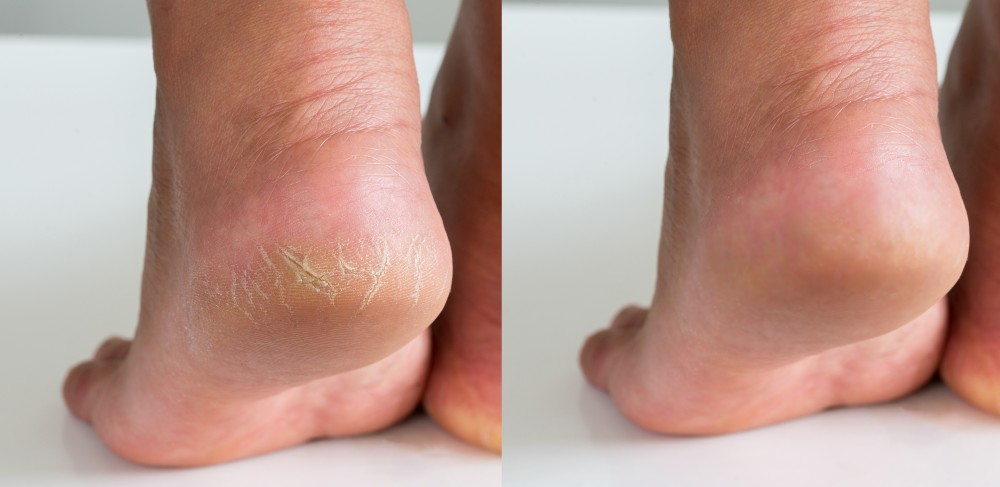Feet that have dry or cracked skin on the heels and/or soles are very common. This is an uncomfortable (and sometimes downright painful) condition that has more than a handful of causes.
Read on for help discovering what may be causing your dry and cracked feet, along with tips on how to handle it effectively.
Why Do I Have Dry Feet or Cracked Feet?
Several factors can cause dry feet, including the following.
Obesity
No matter your body weight, your feet naturally expand as you walk. This can lead to dry/cracked feet in the average person, but when your body is heavier, the risk of your feet becoming dry or cracked is greater. Maintaining a healthy weight can help to offset the risk of dry/cracked feet.
Diabetes
Diabetics are prone to various foot ailments, with dry or cracked feet being one of them. This is due to nerve damage that causes changes in your skin oils, leaving your feet susceptible to dryness or cracking. Maintaining good awareness of your skin’s condition and keeping them moisturized can help to prevent this.
Eczema
Eczema is a skin condition that often results in patches of dry, cracked skin. These patches can occur anywhere on the body, including the feet. Keeping up with your prescribed eczema medications can help to minimize flare-ups, including dry or cracked skin on the feet.
Hypothyroidism
Hypothyroidism causes hormone imbalances, which often lead to dry skin on the soles and heels of the feet. This skin can become cracked and lead to painful fissures if left unchecked. Your thyroid medication should help with this but contacting our podiatrists can offer additional support if needed.
Sjögren’s Syndrome
Sjögren’s syndrome is an autoimmune condition that often starts with rashes on the legs and feet. It commonly presents with dry, cracked skin and can be a contributing factor to painful skin conditions, including dry and cracked feet. Keeping the skin’s moisture at optimal levels can sometimes help with this.
Juvenile Plantar Dermatosis
Juvenile plantar dermatosis most commonly occurs between the ages of three and 14 years and is more prevalent in boys (though girls can also experience it). The condition causes cracking and peeling of the soles of the feet and can often be mitigated by keeping these areas adequately moisturized.
Athlete’s Foot
Athlete’s foot often causes dry skin due to its associated irritation, scratching, and peeling. An anti-fungal prescription for the fungus that causes athlete’s foot will take the itch away, but the skin may need time to recover depending on severity. Drying feet adequately after washing, going barefoot when possible, and using a gentle moisturizer should help.
Flat Feet
The friction build up and weight distribution differences of people with flat feet can also be a risk factor for dry and cracked foot skin. It’s essential to wear shoes that provide optimal support, as well as custom orthotics if you have flat feet — to maintain your posture as well as your skin health.
Heel Spurs
Heel spurs add significant pressure to the skin on your feet from the inside, which can stimulate growth of additional skin in an effort to protect your foot. Unfortunately, this extra skin often becomes dry and cracked, causing more pain than the heel spurs themselves. Addressing your heel spurs with our podiatrists is the best course of action to take, for the spurs as well as the dry/cracked skin.
Standing for Long Periods
Standing for extended periods of time also leads to an increased risk of dry and cracked feet, especially when done on hard surfaces. Hard flooring allows no “give” for the feet, forcing them to spread as they do while walking, only they remain this way while bearing the body’s full weight.
Open-Heeled or Poorly Fitted Shoes
Poorly fitted or open-heeled shoes expose the skin on the feet to excess pressure and environmental irritants, respectively. Both of these scenarios can cause the skin to dry out and crack, becoming worse if the footwear remains unchanged. Properly fitted, supportive shoes that protect all areas of the foot can help in this case.
Dry, Cold Weather
Cold and dry weather has long been to blame for many dry skin issues, as the lack of moisture in the air is first noticed by the skin. The feet are susceptible to this as well, especially as they’re often bundled up during the winter months. Adequate moisture can be maintained during these times but may require extra effort.
Dangers of Dry Feet or Cracked Feet
Dry and cracked feet are a nuisance and can even become painful. However, there are additional risks to be aware of concerning dry, cracked feet. They include:
Infection: Tiny cracks in dry skin can allow bacteria and viruses to breach the skin barrier, causing issues such as plantar warts, athlete’s foot, and other skin infections.
Heel fissures: Cracks can grow into larger fissures, which are painful and can affect walking, standing, and other activities.
Treating Dry Feet or Cracked Feet
There are actions you can take at home to soothe and treat your dry and cracked feet, including soaking your feet in warm water and Epsom salts, gently exfoliating the heels with a clean pumice stone, and applying a thick moisturizer. Putting on clean socks after moisturizing can also help to seal in the moisture, which many people do before bed.
If your dry or cracked skin is painful, showing signs of infection, or if you have diabetes, we highly recommend you see our podiatrists for treatment.
Contact Us Today for Help with Dry Feet or Cracked Feet
If you’re dealing with persistent dry or cracked feet and aren’t seeing progress with home care methods, our podiatrists are here for you. We specialize in getting your feet back to their normal, healthy state, and can offer the helpful advice, treatment, and support you need to do just that.
Contact us for an appointment today, and let us help you wave goodbye to your dry, cracked feet for good!


